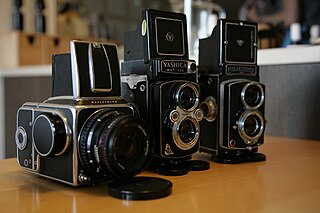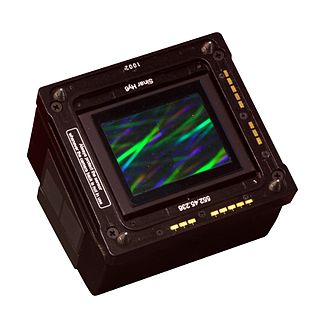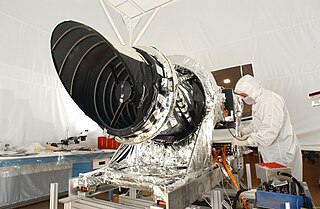
In digital imaging, a pixel, pel, or picture element is the smallest addressable element in a raster image, or the smallest addressable element in a dot matrix display device. In most digital display devices, pixels are the smallest element that can be manipulated through software.

In computer graphics and digital photography, a raster graphics represents a two-dimensional picture as a rectangular matrix or grid of square pixels, viewable via a computer display, paper, or other display medium. A raster is technically characterized by the width and height of the image in pixels and by the number of bits per pixel. Raster images are stored in image files with varying dissemination, production, generation, and acquisition formats.

Medium format has traditionally referred to a film format in photography and the related cameras and equipment that use film. Nowadays, the term applies to film and digital cameras that record images on media larger than the 24 mm × 36 mm used in 35 mm photography, but smaller than 4 in × 5 in.

Large format refers to any imaging format of 9 cm × 12 cm or larger. Large format is larger than "medium format", the 6 cm × 6 cm or 6 cm × 9 cm size of Hasselblad, Mamiya, Rollei, Kowa, and Pentax cameras, and much larger than the 24 mm × 36 mm frame of 35 mm format.

Konica Minolta, Inc. is a Japanese multinational technology company headquartered in Marunouchi, Chiyoda, Tokyo, with offices in 49 countries worldwide. The company manufactures business and industrial imaging products, including copiers, laser printers, multi-functional peripherals (MFPs) and digital print systems for the production printing market. Konica Minolta's Managed Print Service (MPS) is called Optimised Print Services. The company also makes optical devices, including lenses and LCD film; medical and graphic imaging products, such as X-ray image processing systems, colour proofing systems, and X-ray film; photometers, 3-D digitizers, and other sensing products; and textile printers. It once had camera and photo operations inherited from Konica and Minolta but they were sold in 2006 to Sony, with Sony's Alpha series being the successor SLR division brand.
Pixels per inch (ppi) and pixels per centimetre are measurements of the pixel density of an electronic image device, such as a computer monitor or television display, or image digitizing device such as a camera or image scanner. Horizontal and vertical density are usually the same, as most devices have square pixels, but differ on devices that have non-square pixels. Pixel density is not the same as resolution — where the former describes the amount of detail on a physical surface or device, the latter describes the amount of pixel information regardless of its scale. Considered in another way, a pixel has no inherent size or unit, but when it is printed, displayed, or scanned, then the pixel has both a physical size (dimension) and a pixel density (ppi).

A digital camera back is a device that attaches to the back of a camera in place of the traditional negative film holder and contains an electronic image sensor. This lets cameras that were designed to use film take digital photographs. These camera backs are generally expensive by consumer standards and are primarily built to be attached on medium- and large-format cameras used by professional photographers.
Image resolution is the level of detail an image holds. The term applies to digital images, film images, and other types of images. "Higher resolution" means more image detail. Image resolution can be measured in various ways. Resolution quantifies how close lines can be to each other and still be visibly resolved. Resolution units can be tied to physical sizes, to the overall size of a picture, or to angular subtense. Instead of single lines, line pairs are often used, composed of a dark line and an adjacent light line; for example, a resolution of 10 lines per millimeter means 5 dark lines alternating with 5 light lines, or 5 line pairs per millimeter. Photographic lens and are most often quoted in line pairs per millimeter.

A gigapixel image is a digital image bitmap composed of one billion (109) pixels (picture elements), 1000 times the information captured by a 1 megapixel digital camera. A square image of 31,623 pixels in width and height is one gigapixel. Current technology for creating such very high-resolution images usually involves either making digital image mosaics of many high-resolution digital photographs or using a film negative as large as 12" × 9" (30 cm × 23 cm) up to 18" × 9" (46 cm × 23 cm), which is then scanned with a high-end large-format film scanner with at least 3000 dpi resolution. Only a few cameras are capable of creating a gigapixel image in a single sweep of a scene, such as the Pan-STARRS PS1 and the Gigapxl Camera.

The Nikon D1 is a digital single-lens reflex camera (DSLR) that was made by Nikon Corporation introduced on June 15, 1999. It features a 2.7-megapixel image sensor, 4.5-frames-per-second continuous shooting, and accepts the full range of Nikon F-mount lenses. The camera body strongly resembles the F5 and has the same general layout of controls, allowing users of Nikon film SLR cameras to quickly become proficient in using the camera. Autofocus speed on the D1 series bodies is extremely fast, even with "screw-driven" AF lenses.

High-speed photography is the science of taking pictures of very fast phenomena. In 1948, the Society of Motion Picture and Television Engineers (SMPTE) defined high-speed photography as any set of photographs captured by a camera capable of 69 frames per second or greater, and of at least three consecutive frames. High-speed photography can be considered to be the opposite of time-lapse photography.

Digital photography uses cameras containing arrays of electronic photodetectors interfaced to an analog-to-digital converter (ADC) to produce images focused by a lens, as opposed to an exposure on photographic film. The digitized image is stored as a computer file ready for further digital processing, viewing, electronic publishing, or digital printing. It is a form of digital imaging based on gathering visible light.

High Resolution Imaging Science Experiment is a camera on board the Mars Reconnaissance Orbiter which has been orbiting and studying Mars since 2006. The 65 kg (143 lb), US$40 million instrument was built under the direction of the University of Arizona's Lunar and Planetary Laboratory by Ball Aerospace & Technologies Corp. It consists of a 0.5 m (19.7 in) aperture reflecting telescope, the largest so far of any deep space mission, which allows it to take pictures of Mars with resolutions of 0.3 m/pixel, resolving objects below a meter across.

GigaPan Systems is a global, privately held technology company that provides hardware, software, and services to create and share high-resolution, interactive gigapixel panoramic images. The company is headquartered in Portland, Oregon.

Scanography, more commonly referred to as scanner photography, is the process of capturing digitized images of objects for the purpose of creating printable art using a flatbed "photo" scanner with a CCD array capturing device. Fine art scanography differs from traditional document scanning by using atypical objects, often three-dimensional, as well as from photography, due to the nature of the scanner's operation.
The merits of digital versus film photography were considered by photographers and filmmakers in the early 21st century after consumer digital cameras became widely available. Digital photography and digital cinematography have both advantages and disadvantages relative to still film and motion picture film photography. In the 21st century, photography came to be predominantly digital, but traditional photochemical methods continue to serve many users and applications.

The Nikon D3 is a 12.0-megapixel professional-grade full frame (35 mm) digital single lens reflex camera (DSLR) announced by the Nikon Corporation on 23 August 2007 along with the Nikon D300 DX format camera. It was Nikon's first full-frame DSLR. The D3, along with the Nikon D3X, was a flagship model in Nikon's line of DSLRs, superseding the D2Hs and D2Xs. It was replaced by the D3S as Nikon's flagship DSLR. The D3, D3X, D3S, D4, D4s, D5, D6, D700, D800, D800Е and Df are the only Nikon FX format DSLRs manufactured in Japan. The D3S was replaced by the D4 in 2012.
ImageAmerica Aviation, Inc. is an aerial photography company that was acquired by Google in July 2007. The company specialized in creating aerial photos with "accuracy, quick delivery and low cost". It previously sold its services primarily to city, county, state, and federal governments and to corporate customers. ImageAmerica also made money by selling low-cost imagery to county appraisers and assessors. The company's clients include the Texas Department of Transportation, the U.S. Geological Survey, and the Lucas County office that covers Toledo, Ohio. For satellite imaging, the company charges US$99 per 1 square mile (2.6 km2), compared to other companies which could charge from $500 to $700 and for a lower quality than what ImageAmerica offers. It also developed its own DDP-2 camera system. The system is housed in an aircraft. It has the ability to capture details as small as 6 inches (150 mm) to 12 inches (300 mm). ImageAmerica's patented processing system has the ability to produce orthorectified imagery corrected for perspective distortions. The company's technology also uses sensors which are based on a unique design from Sarnoff Research Labs in Princeton, New Jersey.
The Ricoh 500SE digital compact camera is suitable for outdoor photography and networkability. Capability includes external information such as GPS position or barcode numbers within the image headers. External vendors sell hardware and software for workflows involving GPS positioning or barcode scanning. Most NMEA compliant bluetooth GPS receivers can be used with this camera through its built in bluetooth communication capability. The body is resistant to dust and water, making it robust for many environments.












